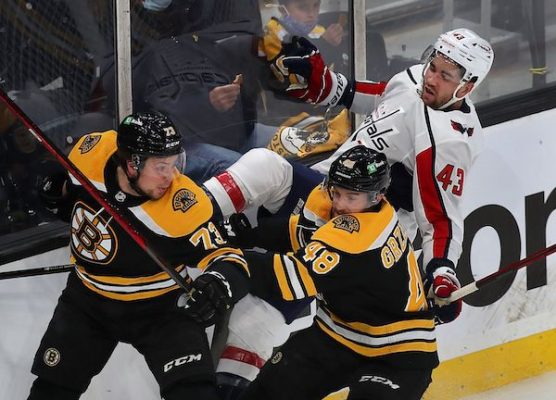
By: Scott Wood | Follow me on Twitter @ScottHoHPodcast
After the Boston Bruins concluded their disappointing 2021 playoff run, many questions lingered about the strength of the roster. The Islanders sported a fierce four-line attack that the Bruins seemed to have no answer for. Whether one blamed an apparent lack of forward depth, dried up scoring from the newly formed second line of Taylor Hall, David Krejci, and Craig Smith, or an injured goaltender. Tuukka Rask winced through the pain of both a hip injury and an atypically porous performance; there were more reasons for fans to be upset at the results than fingers available to point them out.
One aspect of the roster that has received near-universal panning is the makeup of the defense. Too soft, too small, and lacking a genuine number 2 to compliment Charlie McAvoy, which leaves the elite defender with much of the heavy lifting.
How far off was the Bs blueline from being Cup-worthy? And are the changes in the off-season enough to push it over the top for 2021-22? What is missing?
By any quantifiable metric, the first pair of Matt Grzelcyk and Charlie McAvoy are among the NHL’s very best. Among any pairing that played 200 minutes or more together in 2021, this one ranked second to only Mark Giordano and Brandon Tanev (a pair that no longer plays together in Calgary) in expected goals percentage and first in Corsi (shot attempts for %). They were also adept offensively, with McAvoy putting up 30 points in 51 games, and Grzelcyk adding 20 of his own in just 37.
One doesn’t require statistics, however, to understand how effective this pairing is. The eye test should be enough for any Bruins fan. On a nightly basis, these two are in complete control of the puck and the flow of the game when on the ice together.
For some, however, the only numbers that matter are 5 and 9, and Grzelcyk will never get the respect he deserves for the results he produces.
Trade deadline acquisition Mike Reilly was re-signed, and Derek Forbort was brought in the off-season in moves that come without a lot of fanfare, but both players with their own particular set of skills that contribute to the whole of the defense.
Reilly’s ability to move the puck was a shot in the arm for the Bruins. He spent time with almost every RH defender on the team and worked well with every one of them, but none more than the rangy Brandon Carlo. Carlo’s size, agility and positioning meshed so well with Reilly’s heads’ up transition play, that they were the club’s second most-used pair in the playoffs and oftentimes their most consistent. That this coupling appears to be the plan going into 21-22 is a distinct improvement to the rotating left side of unknowns that the Bruins trotted out last season.
Forbort was a high draft pick who never lived up to the promise of a player selected at 15 overall. Like Carlo, however, Forbort is a big defender (6’4”, 220 lbs) with excellent skating ability who has regularly skated 20+ minutes a night, in a top-4 role wherever he has played. Unlike Carlo though, Forbort is physical and not afraid to use his large frame carve out space in the defensive zone, boxing/laying out aggressive forwards who challenge his space and take liberties with his teammates.
Forbort and Connor Clifton will likely make up the Bruins bottom tandem. While erratic at times, “Cliffy Hockey” is a fan-favorite among the Bruins faithful, punching above his weight class in many physical altercations, moving the puck well, and providing unique energy and confidence in a replacement role. When Jeremy Lauzon was chosen by the Seattle Kraken in the expansion draft, many feared that Clifton would be selected instead, despite the former being traditionally more effective and having a more versatile skill set.
Clifton also stepped up big in the playoffs after injuries to Carlo, Kevan Miller, and Steve Kampfer left the Bruins scrambling for replacements.
This leads to where I believe the Bruins are still lacking. Time and again, when Brandon Carlo gets hurt during or directly before the playoffs, he represents the tipping point between a sound six-man unit and a club struggling to keep their heads above water in their own zone.
After Carlo went down this year, the Bruins went from being in control of the second round, leading 2-1, to dropping the next three games with no answer defensively for Barry Trotz’s hard-working Islanders. Sweeney needed (needs) to acquire a player with size and agility who can help plug that hole when Carlo suffers his untimely clockwork injury in the post-season.

Neither Jacob Zboril nor Urho Vaakanainen (arguably 7 and 9 on the depth chart respectively) are suited to this role, with Zboril showing at his best to be solid but unspectacular on the left side last season and Vaakanainen who struggled with consistency in Providence, let alone in the NHL. The forgotten John Moore is reportedly healthy and can slide over to the right, but how well he integrates back into the lineup after a year-and-a-half of IR is more problematic than exciting.
History dictates that the Bruins will have to adjust for injury on the right side of the defense and the current makeup of the team just isn’t versatile enough to do so without imploding. That’s the bad news.
The good news? Contrary to popular belief, they don’t require a top-pairing defenseman to ice one of the best six-man blueline units in the league.


Leave a Reply